May 21, 2025 | 00:31 GMT +7
May 21, 2025 | 00:31 GMT +7
Hotline: 0913.378.918
May 21, 2025 | 00:31 GMT +7
Hotline: 0913.378.918
“How saline it is!”. That was the exclamation of the leader of Hung Loi Agricultural Cooperative, Long Phu district, Soc Trang province, when reporters from Vietnam Agricultural Newspapers asked about the production situation. The story of high saltwater levels is no longer strange to farmers here because of the characteristics of being a locality bordering the sea. Almost every year at this time, farmers all stop rice production and dig up the soil to dry.
However, this year, rice prices are at a high level, so even though the specialized sector has warned about the severe developments of saltwater intrusion, some farmers still spontaneously produce the late winter-spring crop.

Many rivers and canals in Soc Trang province have been dry for many days. Photo: Kim Anh.
Mr. Truong Van Hung, Director of Hung Loi Agricultural Cooperative, said that in recent days, the salinity of water inside irrigation sluices has continuously been above 2‰. Despite the initial damages to agricultural production recorded, compared to some other provinces and cities in saline areas, he still feels more secure when the source of clean domestic water for people in the area is still guaranteed.
According to Mr. Hung, in the severe drought and salinity period of 2015–2016, the pipeline system carrying clean water to rural areas in the area was not guaranteed, so people had to take advantage of groundwater pumped from drilled wells. However, it was not enough to use, so people had to save every drop of water. “At that time, the water after washing vegetables must be kept for washing dishes. Now, the pipelines carrying clean water for people have covered the entire area," Mr. Hung excitedly said.
In addition to Long Phu district, Tran De is also one of the localities in the hot spot for clean domestic water during the dry season in Soc Trang province. According to local records, during the historic drought and salinity period of 2015–2016, the entire district had about 2,500 households lacking clean domestic water.
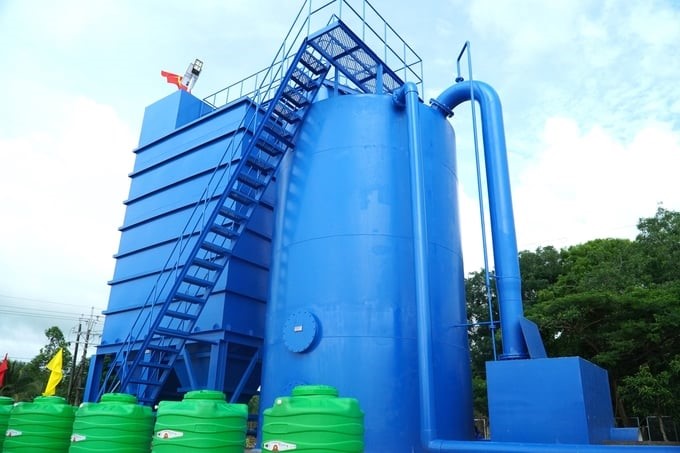
A centralized water supply station with over VND 8 billion in social capital was invested in Tan Hung commune, Long Phu district. Photo: Kim Anh.
During the period of drought and salinity in 2019–2020, the domestic water pressure for people here became more difficult. The Center for Clean Water and Rural Environmental Sanitation in Soc Trang province must organize free clean water supply trips to each remote hamlet of Tran De district to provide for people.
Particularly in Vinh Chau town, because the majority of the population lives in an unconcentrated manner and economic life is still difficult, providing clean domestic water for people is a major obstacle for the locality.
Statistics show that in the town, there are 15 centralized water supply projects managed and operated by the Center for Clean Water and Rural Environmental Sanitation in Soc Trang province. The total licensed capacity is over 14,300 m3/day and night for the entire pipelineline length of over 530 km, capable of providing clean water to 18,650 households. However, in reality, the number of households participating in the connection on this pipelineline is still limited due to difficult economic conditions.
To ensure a clean water source for people during this drought and salinity season, the Center for Clean Water and Rural Environmental Sanitation in Soc Trang province has prioritized completely free installation and connection for people living far from concentrated residential areas or in areas affected by saltwater intrusion. At the same time, the unit promptly solves immediate difficulties for families without conditions.
With more than 80% of the population living in alum areas with seasonal salinity, the use of surface water in Soc Trang is very limited; most households have to use groundwater.
According to statistics from the Center for Clean Water and Rural Environmental Sanitation in Soc Trang province, during the historic drought and salinity period of 2015–2016, the whole province had about 43,000 households having difficulty with domestic water. Of these, 2,400 households seriously lacked domestic water and had to buy and transport water for daily use.
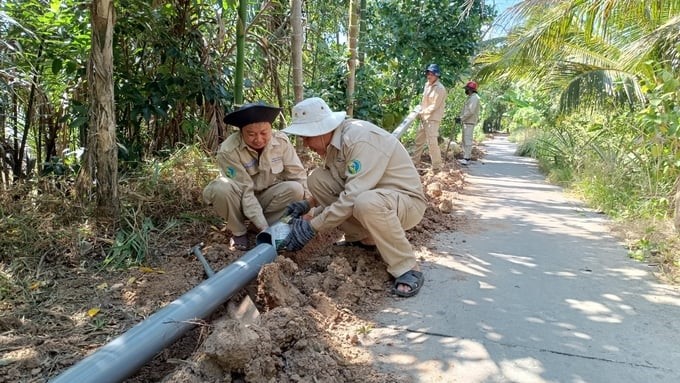
The Provincial Center for Clean Water and Rural Environmental Sanitation strengthens pipeline connections between water supply stations to meet the increased demand of people during the peak months of the dry season. Photo: Kim Anh.
By the period 2019–2020, the above-mentioned number had decreased to 24,000 households affected by domestic water. The main cause was that surface water in rivers, canals, ponds, and lakes was dry or saline. Meanwhile, the groundwater source from households' shallowly drilled wells declined, was exhausted, and was not enough for exploitation and use.
At this point, there is no rush to confirm that Soc Trang people do not lack clean water for use because drought and salinity are forecast to continue prolonging. However, with profound lessons learned from previous drought and salinity sessions, local specialized agencies have had solutions in advance with a long-term vision.
Right from the beginning of the 2023–2024 dry season, the Soc Trang Provincial People's Committee has issued a plan for preventing and controlling drought, water shortage, and saltwater intrusion to serve agricultural production and the people.
This plan stipulates in detail and specifically the responsibilities of each specialized agency, especially the role of water supply units that must ensure the quantity and quality of service. The plan’s focus is to strengthen the inspection and maintenance of water supply systems at water factories. Prepare adequate backup materials, promptly fix damages on the pipeline route, and ensure continuous operation of water factories.
In addition, the provincial leaders also requested to organize salinity measurements at factories to have specific water distribution plans for each period and make reasonable adjustments when water sources are in short supply. Of which, priority is given to providing water for essential needs such as living activities, industry, livestock farming, and annual and perennial crops during times of saltwater intrusion.
Mr. Nguyen Thanh Dung, Director of the Center for Clean Water and Rural Environmental Sanitation in Soc Trang province, said that the unit has planned to open public water supply points to get free water for people in the area at the end of the pipelineline.
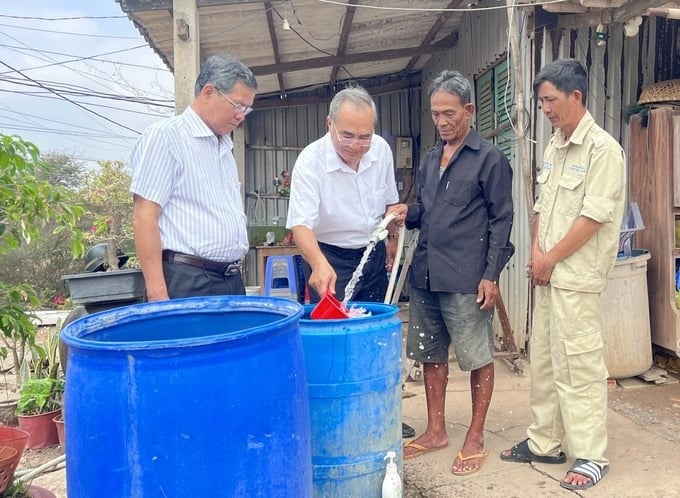
Leaders of the Soc Trang agricultural sector check the quality of water sources for people's living activities in localities affected by saltwater intrusion. Photo: Kim Anh.
At the same time, the unit has also equipped trucks and water tanks, ready to deliver clean water to people if there is a serious shortage of domestic water during this drought and saltwater intrusion.
Currently, the unit is monitoring the rinsing of the filtration system at the stations and water supply through the camera system. Data will be transmitted to the Center's Office of Supervision and Operations (IOC). From there, regulatory solutions will be timely issued to ensure water source quality.
According to Mr. Dung, as of now, Soc Trang province is capable of meeting people's domestic water needs in 2024.
Previously, the Soc Trang Provincial People's Committee also implemented a rural clean water supply project in the entire province for the 2023–2030 period, with the goal of upgrading and expanding 258,000m of pipelinelines in the entire province, serving an additional 10,000 households during this drought and salinity period. Four water supply stations under the water supply project in water-scarce areas in the province are also under construction.
From the central budget to support overcoming drought and saltwater intrusion in 2020, Soc Trang province has implemented 35 projects to expand the water supply pipeline network, with a total length of over 123,000m. Thereby ensuring water supply for more than 3,200 households in the districts of Tran De, My Tu, Cu Lao Dung, My Xuyen, Chau Thanh, and Vinh Chau town.
Translated by Huyen Vu Thu

(VAN) In 2024, over 295 million people across 53 countries and territories faced acute hunger—an increase of almost 14 million people compared to 2023, while the number of people facing catastrophic levels of hunger reached a record high.

(VAN) World Environment Day 2025 (June 5) carries the theme 'Beat Plastic Pollution' continuing to emphasize the global urgency of addressing the plastic waste crisis.

(VAN) This was the assessment shared by experts at the workshop titled 'Assessing the Role and Potential of Low-Emission Rice Production Systems in Vietnam,' held on the morning of May 19.

(VAN) Cai Rong Port is the fisheries control center of Quang Ninh, helping to monitor fishing vessels, combat IUU fishing, and remove the EC's 'yellow card'.
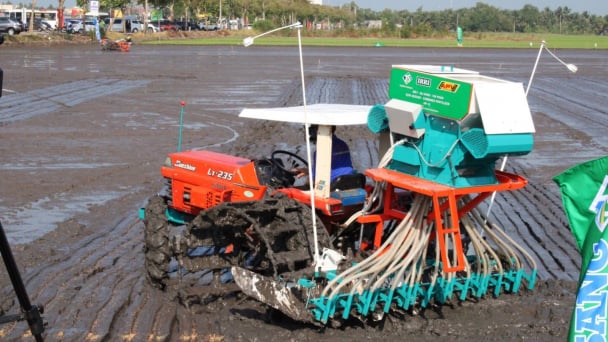
(VAN) The German Agricultural Society (DLG) explores the possibility of establishing a mechanization service center in Vietnam’s Mekong Delta to support farmers in accessing and utilizing advanced machinery.
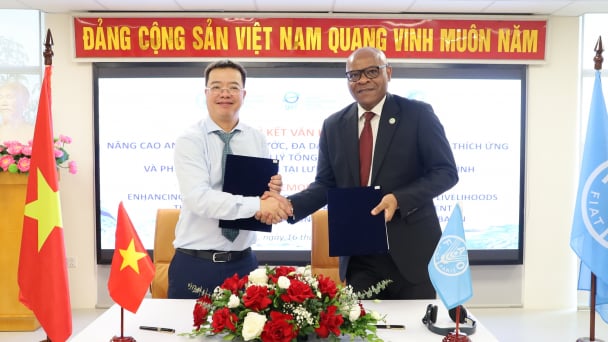
(VAN) On May 16, the Department of Water Resources Management, in collaboration with the Food and Agriculture Organization of the United Nations (FAO), held a signing ceremony for the GEF-8 project document.

(VAN) Food safety, mechanization, vocational training, and market opening are key areas of cooperation expected between the Vietnamese Government and the Federal Republic of Germany.